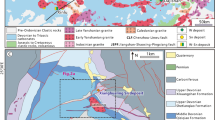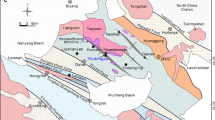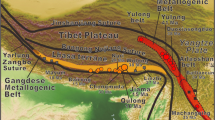Abstract
Tungsten is a characteristic element of the South China-type massive sulphide deposits that were formed on the continental crust. The high contents of tungsten in these deposits are attributed to the primary enrichment of this element in the basement sequences of the region, providing an indication of the tungsten-enrichment in the continental crust. Tungsten in the basement sequences was mobilized and transported to the massive sulphides by a combination of different geological processes such as terrigenous sedimentation, submarine hydrothermal deposition and magmatic hydrothermal superimposition.
Similar content being viewed by others
References
Burke, K., 1977, Evolution of continental rift system in the light of plate tectonics, in Neuman, E. R. and Ramberg, I. B. (eds.), Tectonics and Geophysics of Continental Rifts: D. Reidel Publishing Company, p. 1–10.
Chen Yuchan, Tang Xingxin and Ma Xiujuan, 1981, Secondary enrichment of tungsten in the oxidized zones of tungsten-iron and cupreous pyrite deposits: The Proceedings of Symposium on Tungsten Geology: Beijing, Geological Publishing House, p. 3–24 (in Chinese).
Fu Shigu, 1977, Geology of the pyrite-type copper deposits in the Lower Yangtze belt: Journal of Nanjing University (Natural Sciences Edition), n. 4, p.43–67 (in Chinese).
Gu Lianxing, 1984a, The Middle Carboniferous marine volcanics and the origin of layered ores in Wushan, Jiangxi Province: Journal of Guilin College of Geology, v. 4, p. 91–102 (in Chinese with English abstract).
Gu Lianxing, 1984b, Metal zonations of the South China-type massive sulphide and related deposits: Journal of Nanjing University (Geology Edition), n. 4, p. 57–71 (in Chinese with English abstract).
Gu Lianxing and Xu Keqin, 1986a, On the South China-type massive sulphide ore deposits formed in marine fault depressions in the continental crust: Mineral Deposits, v. 5, p. 1–13 (in Chinese with English abstract).
Gu Lianxing and Xu Keqin, 1986b, On the Carboniferous submarine massive sulphide deposits in the lower reaches of the Changjiang (Yangtze) River: Acta Geologica Sinica, n. 2, p. 176–188 (in Chinese with English abstract).
Gu Lianxing, 1987a, Genetic relationship between stratiform manganese ores and leadzinc veinlets in the Lehua mine, Jiangxi Province: Geological Review, v. 33, p.267–274 (in Chinese with English abstract).
Gu Lianxing and Xu Keqin, 1987b, The tectonic development and related metallogenesis of the Lower Yangtze fault depression belt: Journal of Guilin College, v. 7, p. 243–252 (in Chinese with English abstract).
Xu Keqin, Zhu Jinchu, and Ren Chikang, 1980, On the origin of some iron and copper deposits in several marine fault depressions of southeastern China, in Scientific Papers on Geology for International Exchange for the 26th International Geological Congress, Part 3, Metallogenesis and Mineral Ores: Beijing, Geological Publishing House, p. 49–58 (in Chinese).
Hu Shouxi and Lin Qianlong, 1988, Geology and Metallogeny of the Amalgamating Zone between the North China and the South China Ancient Plates: Nanjing, Najing University Publishing House, p. 507–511.
Hua Youren and Hu Zhiguo, 1980, Genesis of the Fenglin tungsten-copper deposit: Geology and Prospecting, n.11, p. 8–14 (in Chinese).
Hutchinson, C. S., 1981, Granite series and their relations to tungsten and tin mineralizations, The Proceedings of Symposium on Tungsten Geology: Beijing, Geological Publishing House, p. 443–472 (in Chinese).
Lehmann, B. and Schneider, H. J., 1981, Strata-bound Tin Deposits, in Wolf, K. H., ed., Handbook of Strata-bound and Stratiform Ore Deposits: v. 9, p. 743–768.
Liu Xiaoshan, Chen Zhuqi and Chen Yongqing, 1979, The texture and structure of ores from the sulphide deposits of Chishiashan, Nanjing, and their implications to ore genesis: Journal of Nanjing University (Natural Science Edition), n. 4, p. 75–94 (in Chinese with English abstract).
Liu Yingjun and Ma Dongsheng, 1987, Geochemistry of Tungsten: Beijing, Science Press, 232p (in Chinese).
Liu Yingjun, Li Zaolin, Xie Shaoqin, Zhao Meifang, Jiang Haoshen and Wu Qizhi, 1981, Geochemical experiments on the tungsten deposits of South China, The Proceedings of Symposium on Tungsten Geology: Beijing, Geological Publishing House, p. 127–141 (in Chinese).
Tang Guiqiu, 1985a, Geology and genesis of the iron-manganese polymetallic deposit at Manaoshan, Hunan Province, A Collection of Papers on Manganese Deposits in China (Edited by Department of Regional and Economic Geology, Ministry of Geology and Mineral Resources): Beijing, Geological Publishing House, p. 174–177 (in Chinese).
Xu Keqin and Zhu Jinchu, 1978, Origin of the sedimentary-(or volcano-sedimentary) iron-copper deposits in some fault depression belts in Southeast China: Fujian Geology, n. 4, p. 1–68 (in Chinese).
Xu Keqin and Zhu Jinchu, 1987, Temporal and spacial distributions of and metallogenic constraints on tungsten and tin deposits in South China, The Proceedings of Symposium on Tin Geology: Beijing, Geological Publishing House, p. 50–59 (in Chinese).
Zhang Guolin and Chai Hongyuan, 1987, Genesis of the Dachang tin polymetallic deposit, Guangxi: Geological Review, v. 33, p. 426–436 (in Chinese with English abstract).
Zhang Hua, 1982, Strata-bound tungsten deposits in Jiangxi Province: Metallurgical Geology of East China, n. 2, p. 1–11.
Zhang Ligang, 1985, The Application of Stable Isotopes to Geology: Xi’an, Shaanxi Science and Technology Publishing House, 267p.
Zheng Sujuan and Xia Zhiwu, 1989, A study on molybdenum-bearing scheelite in the Sandaozhuang skarntype Mo-W deposit, Henan Province, China: Journal of Nanjing University (Earth Science Edition), n. 1–2, p. 135–145 (in Chinese).
Zheng Yanzhun and Zhang Juntai, 1989, Genetic model for ore deposits of submarine volcanic origin: Abstracts for the 4th National Symposium on Mineral Deposits, 5p. (in Chinese).
Zhou Huaiyang, Xu Keqin, Ye Jun and Chen Zhuqi, 1987, Geological features and ore-forming mechanism of the Dachang strata-bound cassiterite-sulphide polymetallic deposit, Guangxi: Journal of Nanjing University (Natural Science Edition), v. 23, 534–544 (in Chinese with English abstract).
Zhu Jinchu and Zhang Chenghua, 1981, On the occurrence of Carboniferous volcanics and origin of copper and tungsten deposits of the Fenlin district, Dongxiang, Jiangxi: Journal of Nanjing University (Natural Science Edition), n. 2, p. 269–282 (in Chinese with English abstract).
Author information
Authors and Affiliations
Additional information
This project was financially supported by the National Natural Science Foundation of China.
Rights and permissions
About this article
Cite this article
Gu, L., Yang, H., Zheng, S. et al. Tungsten enrichment in the South China-type massive sulphide deposits. Chin. J. of Geochem. 11, 344–351 (1992). https://doi.org/10.1007/BF02869065
Issue Date:
DOI: https://doi.org/10.1007/BF02869065




